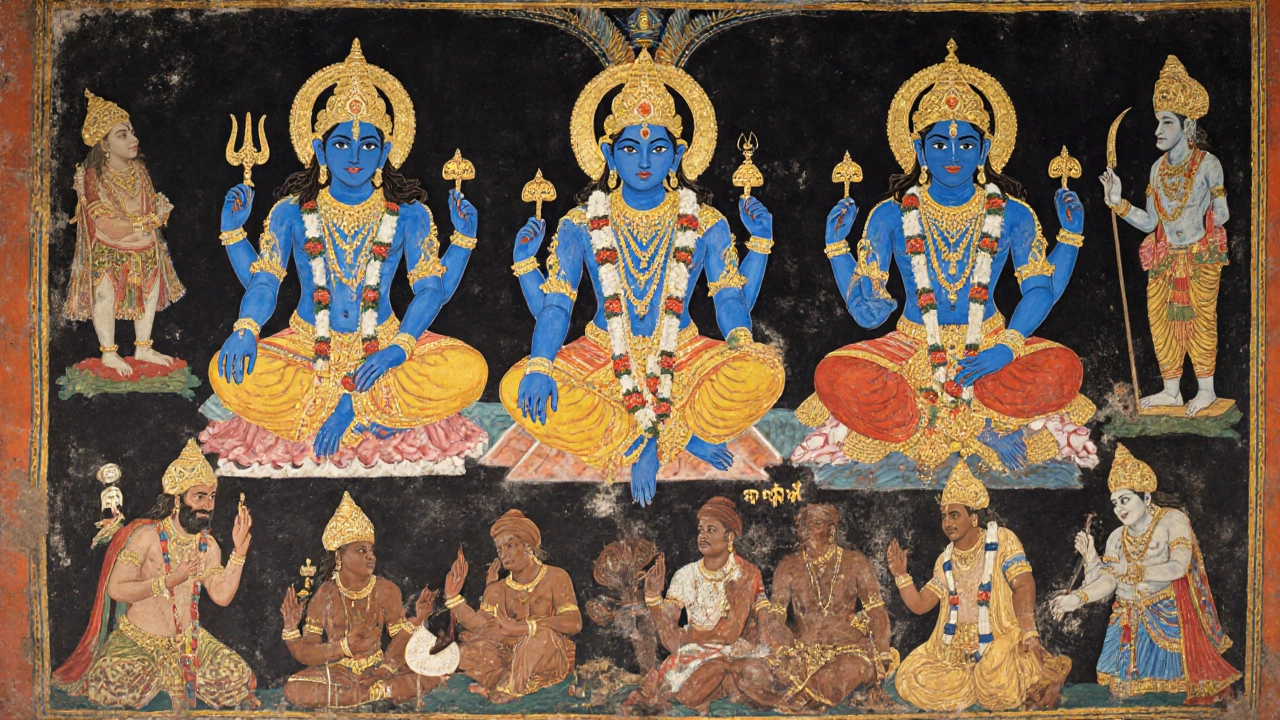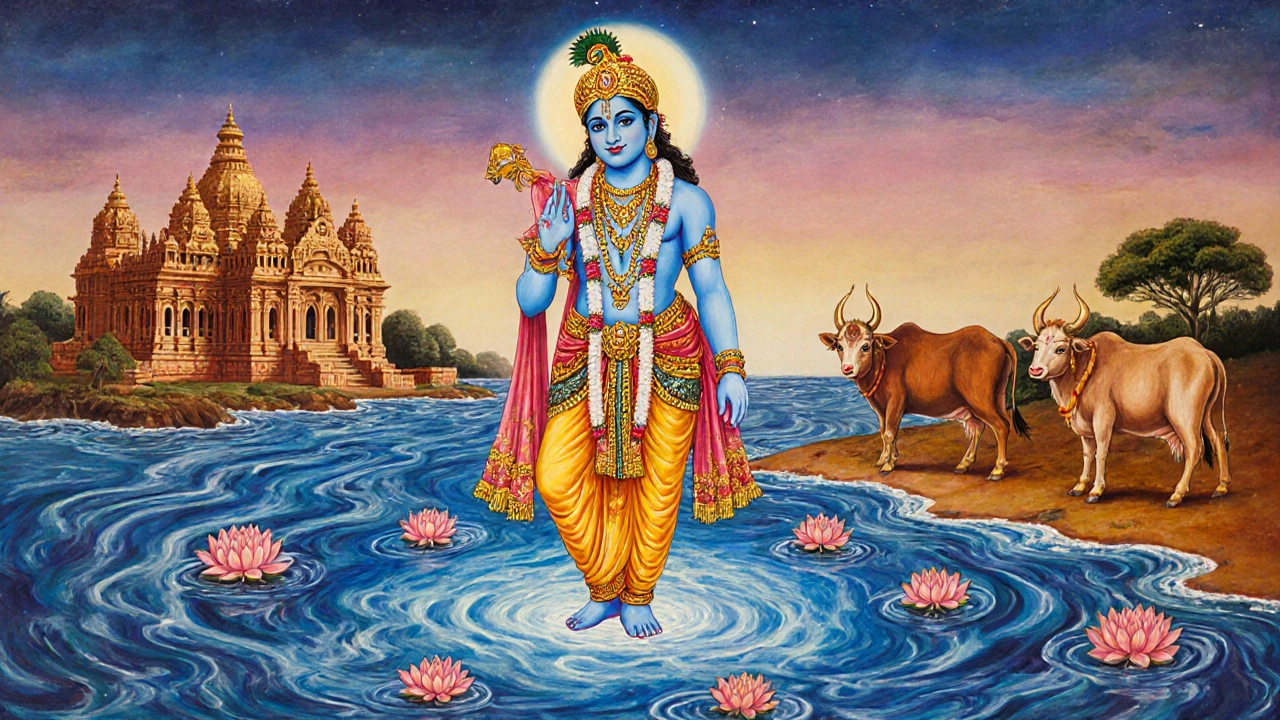Look at any traditional painting of Lord Krishna, Shiva, or Vishnu, and one thing stands out immediately: their skin is blue. Not dark, not gray, not brown-blue. It’s not a mistake. It’s not a style choice from a distant era. It’s a deliberate, deeply symbolic act rooted in ancient Indian art and spiritual thought. So why blue? The answer isn’t just about aesthetics. It’s about power, infinity, and the unseen forces that shape the universe.
The Color of the Infinite
In Indian art, blue doesn’t mean what it means in Western painting. It’s not the color of the sky or the sea, though those are related. Blue here represents the boundless. The vastness of the cosmos. The depth of consciousness beyond thought. Ancient artists didn’t have access to modern pigments, but they knew how to make indigo from plants, and lapis lazuli from distant mines. They used these because they were rare, precious, and carried meaning.
When you see Krishna’s blue skin, you’re not seeing a human being. You’re seeing the divine as something beyond physical form. The color blue in Hindu iconography is tied to the concept of ananta-the infinite. Vishnu, the preserver, is often shown lying on the cosmic ocean, his skin blue like the endless waters. Shiva, the destroyer and transformer, wears blue because he holds the poison from the churning of the ocean, turning death into power. His throat turned blue from swallowing it, and that’s why he’s called Neelakantha-the blue-throated one.
Blue as a Symbol of Divine Power
Blue isn’t just a background color in these images. It’s the main character. In the Bhagavad Gita, when Krishna reveals his universal form to Arjuna, he shows himself as a being with countless faces and arms, glowing with the light of a thousand suns. The color described? Blue. Not because he looked like a cartoon character, but because blue was the only color that could convey the overwhelming, terrifying, awe-inspiring nature of the divine.
Modern psychology tells us that blue calms the mind. Ancient Indian sages knew this too. Blue was used to evoke stillness, depth, and inner awareness. When devotees meditate on a blue-skinned deity, they’re not just looking at a god-they’re being guided inward. The color acts as a visual anchor for the mind, helping it let go of distractions and touch something eternal.
Contrast With Human Skin Tones
Think about how these paintings are composed. The gods are blue. Their companions, warriors, and even their wives are painted in earth tones-ochre, red, brown, gold. This isn’t accidental. It’s a visual language. The blue skin sets the divine apart. It says: this being is not of this world. Not bound by hunger, fatigue, fear, or death. Human figures are shown with warmth, texture, and variation. Divine figures are shown with unity, stillness, and a single, unchanging hue.
This contrast was especially important in temple art, where paintings and carvings were meant to be seen by people who couldn’t read sacred texts. The color blue became a shortcut to understanding divinity. You didn’t need to know the stories. You just needed to see the blue and know: this is something beyond you.

Historical Use of Pigments
Blue wasn’t easy to get in ancient India. Indigo, made from the leaves of the Indigofera tinctoria plant, was the most common source. It required careful fermentation and long processing. Lapis lazuli, imported from Afghanistan, was even more valuable than gold. Only the most sacred images got the real lapis. That’s why blue became associated with holiness-it was expensive, rare, and hard to make.
Temple artists, known as sthapatis, were trained for years. They didn’t just paint. They followed strict guidelines from texts like the Shilpa Shastras, which dictated everything from proportions to colors. Blue was reserved for deities, never for ordinary people. Even in murals from the Ajanta caves, dating back over 1,500 years, the gods are blue. The kings and merchants? Brown or red.
Why Not Other Colors?
Some might ask: why not green? Or purple? Green is tied to nature and fertility in Indian tradition, but it’s also the color of the living world. Purple, while regal in the West, wasn’t commonly used in ancient Indian palettes. Blue, however, had no earthly counterpart. It didn’t belong to soil, plants, or animals. It was the color of the sky above and the ocean below-the two things that humans have always seen as limitless.
Even in modern Indian cinema and theater, blue is still used to signal divinity. When actors portray Krishna or Shiva on stage, they wear blue makeup. It’s a direct link to centuries-old visual traditions. The color hasn’t changed. The meaning hasn’t faded.

Blue in Other Cultures? A Different Story
It’s worth noting that blue gods are rare outside South Asia. In Greek mythology, Zeus is often shown with a white or golden aura. In Egyptian art, the god Amun is sometimes blue, but that’s linked to the sky and creation-not the same spiritual depth as in Indian art. In Chinese tradition, blue is linked to immortality, but rarely to deities in human form.
India’s use of blue for gods is unique in its consistency and spiritual weight. It’s not a decorative choice. It’s a theological statement.
What Does It Mean for Devotees Today?
For millions of people who still worship these deities, the blue skin isn’t just a relic of the past. It’s a living symbol. When a child sees Krishna in blue, they learn early that divinity is not limited by form. It’s not confined to skin color, gender, or nationality. Blue is the color of the universal soul-beyond caste, beyond race, beyond time.
Even in modern homes, where you might find a plastic Krishna statue on a shelf, the blue remains. It’s a quiet reminder that the divine doesn’t need to look like you to be close to you.
The Deeper Message
At its core, the blue skin of Indian gods is a lesson in perspective. It says: what you see is not what is. The body is temporary. The soul is infinite. The color blue is a visual metaphor for the unchanging truth beneath the changing world.
That’s why, even today, when you see a blue-skinned deity, you don’t just see a painting. You see a doorway. And if you look long enough, you might just see yourself reflected in that blue-not as you are, but as you could be: boundless, calm, and whole.
Why are Hindu gods always shown with blue skin?
Hindu gods like Krishna, Shiva, and Vishnu are shown with blue skin to symbolize their divine, infinite nature. Blue represents the boundless cosmos, the deep ocean, and the vast sky-things beyond human limits. It’s not a literal color but a spiritual signal that these beings exist beyond the physical world.
Is blue skin unique to Indian gods?
Yes, in its consistent and symbolic use, blue skin is unique to Indian religious art. While other cultures, like ancient Egypt, used blue for gods like Amun, it was tied to creation or the sky, not to the concept of infinite consciousness. In India, blue became the standard visual code for divinity across centuries and regions.
Did ancient artists use real blue pigments?
Yes. The most common blue came from indigo plants, which required complex fermentation. For the most sacred images, artists used lapis lazuli, a semi-precious stone imported from Afghanistan. Because it was so rare and expensive, blue became associated with holiness and power.
Why not use black or dark brown for divine figures?
Black and dark brown were used for human figures, especially warriors and kings, to show strength or earthiness. But blue was chosen because it has no direct natural counterpart in the human body or environment. It stood apart-symbolizing something beyond nature, not just darker than humans.
Does the blue skin have anything to do with race or ethnicity?
No. The blue skin is purely symbolic and spiritual. It has nothing to do with the actual skin tone of people in ancient India. The color was chosen to represent transcendence, not physical appearance. In fact, the contrast between blue gods and brown-skinned humans was meant to highlight the difference between the divine and the mortal.
